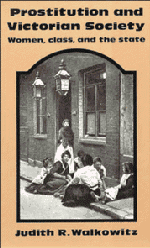Book contents
- Frontmatter
- Contents
- Preface
- Introduction: The Revolt of the Women
- Part I Prostitution, Social Science, and Venereal Disease
- Part II The Contagious Diseases Acts, Regulationists, and Repealers
- 4 The Contagious Diseases Acts and Their Advocates
- 5 The Repeal Campaign
- 6 The Leadership of the Ladies' National Association
- 7 Class and Gender Conflict Within the Repeal Movement
- Part III Two Case Studies: Plymouth and Southampton Under the Contagious Diseases Acts
- Epilog
- Notes
- Selected Bibliography
- Index
6 - The Leadership of the Ladies' National Association
Published online by Cambridge University Press: 01 June 2011
- Frontmatter
- Contents
- Preface
- Introduction: The Revolt of the Women
- Part I Prostitution, Social Science, and Venereal Disease
- Part II The Contagious Diseases Acts, Regulationists, and Repealers
- 4 The Contagious Diseases Acts and Their Advocates
- 5 The Repeal Campaign
- 6 The Leadership of the Ladies' National Association
- 7 Class and Gender Conflict Within the Repeal Movement
- Part III Two Case Studies: Plymouth and Southampton Under the Contagious Diseases Acts
- Epilog
- Notes
- Selected Bibliography
- Index
Summary
We know how to manage any other opposition in the House or in the country, but this is very awkward for us – this revolt of the women. It is quite a new thing; what are we to do with such an opposition as this?
—An M.P. to Josephine Butler, quoted in Josephine E. Butler: An Autobiographical Memoir, eds. George W. Johnson and Lucy Johnson (London, 1909), p. 90.As an association of women only, the Ladies' National Association claimed itself to be “unique in the political history of the country.” The LNA would demonstrate the capacity of women to get along with each other and to organize for a political objective. Mary Priestman, a member of the executive board, wrote in 1907, “It has been often said that women are not loyal to women and that they do not work well together – the experience of the LNA is contrary to this…”
The LNA gave political expression to a supportive female subculture in the mid-Victorian period. Its feminist leaders were composed of a small group of nationally prominent women who were fiercely loyal to each other and to their organization. A biographical profile of the thirty-three members of the LNA executive board helps to identify the formative political and social experiences that prepared these women for national leadership. From this profile, they emerge as an older generation of feminists, linked together by long-standing bonds of friendship and family as well as by shared political experiences.
- Type
- Chapter
- Information
- Prostitution and Victorian SocietyWomen, Class, and the State, pp. 113 - 136Publisher: Cambridge University PressPrint publication year: 1980

